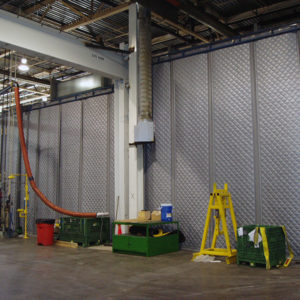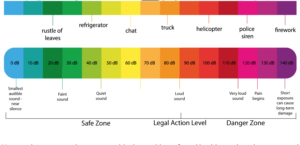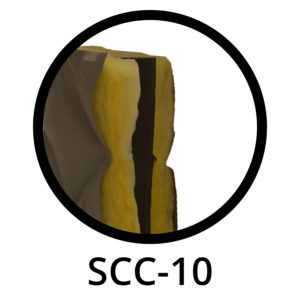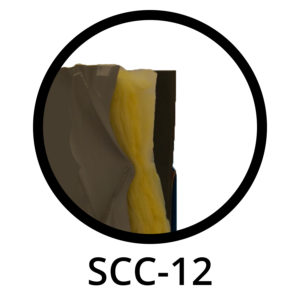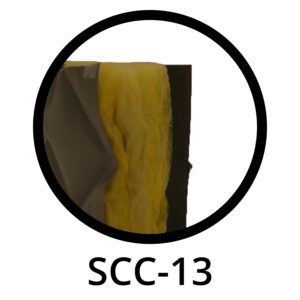American Made, Iron Clad Protected - Discover the Industries Best Warranty.
Blog
Sound Curtains for Industrial Use: How to Buy the Right One
How to Buy the Right Industrial Sound Curtain for Your Plant
Heavy equipment, running machinery, and various other industrial processes produce high levels of noise. Though the use of such processes is essential in commercial settings, the generated noise can disrupt industrial environments.
Excessive noise is equally hazardous to workers’ health and safety. It can further lead to a decrease in their overall productivity, according to research published in the National Library of Medicine. Consequently, it might affect the profitability of any business.
The good news is that you don’t have to face adverse consequences due to constant noise. Since noise produced by heavy machinery has a stronger intensity, you should consider a reliable option to control noise. Sound curtains specifically designed for industrial use can help you get rid of the noise.
How sound curtains work
Sound curtains are made of absorbent and dense material. They absorb sound waves so the sound reflection doesn’t bounce around workspaces. They act as a barrier by reducing the noise coming from loud equipment.
Not all sound curtains are the same. The performance of each brand varies depending on the materials used.
Factors to consider before choosing sound curtains
In commercial settings, choosing the right sound curtains requires a higher level of involvement. Therefore, it’s important to know how to purchase the right sound curtains that are suitable for industrial use. Considering the following factors will help you choose sound curtains that are ideal for your workspaces:
Know the OSHA safety regulations
Excessive exposure to workplace noise can contribute to developing tinnitus and temporary (or even permanent) hearing impairment in employees. This consequence might negatively affect their health and safety. Therefore, OSHA has set legal limitations on excessive noise in workspaces. For an eight-hour shift, employees must not be exposed to more than 85 dBA noise levels, according to OSHA standards.
To maintain the noise level according to OSHA standards, employers need to choose sound curtains that help keep noise levels below 85 dBA. To make this possible, you can consult an acoustic engineer who measures the level of sound a specific machinery generates. For instance, if the noise level of a machinery is 100 dBA, you should choose a sound curtain that absorbs 15 dBA of the noise. That way, you’ll be able to achieve the ideal level of 85 dBA noise level.
Inquire about the soundproofing materials
Sound transmission is directly related to the level of density and mass it is exposed to. The more density and mass a sound curtain has, the better it will absorb sound in a noisy environment. That’s why companies use a special material (often known as mass loaded vinyl or MLV) while manufacturing sound curtains. As an interior layer, MLV enhances the soundproofing capacity of a sound curtain. Usually versions with MLV are referred to Sound Curtains while layered versions without MLV are usually referred to as Sound Blankets or Acoustic Blankets
Fiberglass is another material that makes a sound curtain stand out from other soundproofing methods in terms of effectiveness. As a soft and porous quilted absorber, it’s mostly used as an exterior layer to block noise. So, it’s wise to look for sound curtains that comprise both of these sound absorbing materials.
Determine the level of sound absorption
Noise Reduction Coefficient (NRC) is a rating that measures how effectively industrial sound curtains can absorb sound. It ranges between 0.0 and 1.0. Sound curtains with a higher NRC are said to be the best sound absorbers. So, before choosing one, you should inquire about the NRC rating of the sound curtains and finalize your decision accordingly.
Another way to assess the NRC rating of a sound curtain is to check its density and thickness. The thicker a sound curtain is, the better it will be at absorbing sound.
SOUND ABSORPTION (HZ) PER ASTM C423
| Model Number | 125 | 250 | 500 | 1000 | 2000 | 4000 | NRC |
|---|---|---|---|---|---|---|---|
| SCC-10 & SCC-11 | .18 | .62 | .89 | .84 | .60 | .45 | .75 |
SOUND TRANSMISSION LOSS (HZ) PER ASTM E90 & E413
| Model Number | Barrier | 125 | 250 | 500 | 1000 | 2000 | 4000 | STC |
|---|---|---|---|---|---|---|---|---|
| SCC-10 | 1 lb. | 12 | 16 | 27 | 40 | 44 | 43 | 29 |
| SSC-11 | 2 lb. | 19 | 22 | 28 | 40 | 56 | 61 | 33 |
SOUND ABSORPTION (HZ) PER ASTM C423
| Model Number | Thickness | 125 | 250 | 500 | 1000 | 2000 | 4000 | NRC |
|---|---|---|---|---|---|---|---|---|
| SCC-12 | 1″ | 0.12 | 0.47 | 0.85 | 0.84 | 0.64 | 0.62 | 0.70 |
| SCC-13 | 2″ | 0.07 | 0.27 | 0.96 | 1.13 | 1.08 | .99 | .85 |
SOUND BLOCKING PERFORMANCE (HZ)
| Model Number | Thickness | 125 | 250 | 500 | 1000 | 2000 | 4000 | STC |
|---|---|---|---|---|---|---|---|---|
| SCC-12 | 1″ | 11 | 16 | 24 | 30 | 35 | 35 | 27 |
| SSC-13 | 2″ | 13 | 20 | 29 | 40 | 50 | 55 | 32 |
Ask yourself if you need weather-specific curtains
Heavy machines generate intense heat. Besides, lack of ventilation might further exacerbate the condition. Therefore, industrial strength matters the most if you are looking for sound curtains that offer temperature control. Even if you plan to install industrial sound curtains in an indoor setting, see if these curtains can withstand extreme temperatures.
Weather-resistant sound curtains can be used in both indoor and outdoor settings. So, you can also consider such curtains if you plan to extend your workspaces to outdoor premises.
Decide between floor-mounted and ceiling-mounted sound curtains
Though both options are convenient, the choice between floor-mounted and ceiling-mounted sound curtains depends on your industrial needs. Floor-mounted sound curtains are a feasible option for those who prefer easy installation and reconfiguration.
Ceiling-mounted sound curtains do well if you prefer relocating them. These are also a suitable option if employees frequently enter the workspace and exit by using the same sound curtains.
Take recommendations from peers about extra features
Sometimes it makes sense to go for additional features while choosing industrial sound curtains. Some examples include color specifications, Velcro sealing, and even windows. However, it depends on the current need of a workspace. If the workspace gets heated up quickly due to the constant usage of machines and equipment, it’s a good idea to prefer sound curtains that also provide sufficient ventilation.
Take insights from employees who are currently working in that specific workspace. Based on their opinions, you can order sound curtains that match the needs of your industrial surroundings.
Recent Posts
- The Silent Safety Hero: Why Fixed Draft Curtains Are Required in High-Rack Storage Facilities
- The Invisible Risk: How Contamination Happens Without Proper Warehouse Barriers
- Are Your Insulated Warehouse Curtains Compliant
- Understanding Noise Regulations – When Is a Temporary Noise Barrier Legally Required?
- 7 Powerful Ways Industrial Curtain Walls Boost Employee Productivity
- Noise Enclosures vs. Traditional Soundproofing: Which Is Right for Your Facility?
- Steel Guard Safety Achieves SBA HUBZone Certification, Expanding Government Market Opportunities
- 5 Myths and 5 Truths about Smoke Curtains
- 7 Common Mistakes to Avoid When Setting Up Machine Guarding Fences
- Industrial Curtain Walls: 6 Reasons Why Manufacturing Facilities Must Have Them
Categories
- Accordion Fold Curtains
- Acoustic Baffles
- Agri-Shield Curtains
- Auto Body Shop Curtains
- Bio Plastics
- Draft & Smoke Curtains
- Industrial Divider Curtains
- Industrial Safety Products
- Insulated Curtain Walls
- Machine Guard Safety Fencing
- Mesh Curtain Screens
- News
- Outdoor Curtains
- PVC Strip Curtains
- Smoke & Draft Curtains
- Soundproof Noise Blocking Curtains
- Spray Paint Booth Curtains
- Tarps
- Thermal Curtains & Covers
- Uncategorized
- Warehouse Dividers
- Welding Blankets
- Welding Curtains
- Welding Screens


